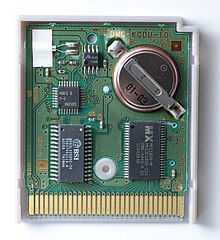
Back ذاكرة القراءة فقط Arabic Memoria de solo llectura AST Daimi yaddaş qurğusu Azerbaijani Пастаянная запамінальная прылада Byelorussian ROM Bulgarian রম Bengali/Bangla ROM BS Memòria ROM Catalan بیرگەی ھەر-خوێندنی CKB ROM Czech
| Computer memory and data storage types |
|---|
| Volatile |
| Non-volatile |

Read-only memory (ROM) is a type of non-volatile memory used in computers and other electronic devices. Data stored in ROM cannot be electronically modified after the manufacture of the memory device. Read-only memory is useful for storing software that is rarely changed during the life of the system, also known as firmware. Software applications, such as video games, for programmable devices can be distributed as plug-in cartridges containing ROM.
Strictly speaking, read-only memory refers to hard-wired memory, such as diode matrix or a mask ROM integrated circuit (IC), that cannot be electronically changed after manufacture. Although discrete circuits can be altered in principle, through the addition of bodge wires and the removal or replacement of components, ICs cannot. Correction of errors, or updates to the software, require new devices to be manufactured and to replace the installed device.
Floating-gate ROM semiconductor memory in the form of erasable programmable read-only memory (EPROM), electrically erasable programmable read-only memory (EEPROM) and flash memory can be erased and re-programmed. But usually, this can only be done at relatively slow speeds, may require special equipment to achieve, and is typically only possible a certain number of times.[1]
The term "ROM" is sometimes used to refer to a ROM device containing specific software or a file with software to be stored in a writable ROM device. For example, users modifying or replacing the Android operating system describe files containing a modified or replacement operating system as "custom ROMs" after the type of storage the file used to be written to, and they may distinguish between ROM (where software and data is stored, usually Flash memory) and RAM.
ROM and RAM are essential components of a computer, each serving distinct roles. RAM, or Random Access Memory, is a temporary, volatile storage medium that loses data when the system powers down. In contrast, ROM, being non-volatile, preserves its data even after the computer is switched off.[2]
- ^ "flash ROM Definition from PC Magazine Encyclopedia". pcmag.com. Archived from the original on November 10, 2013.
- ^ https://pisiup.com/what-is-rom-in-computer/